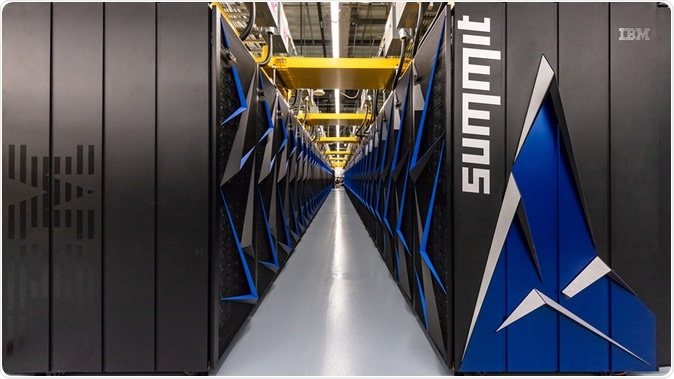What makes the coronavirus disease (COVID-19) global pandemic different from the Spanish flu in 1918? In 1918, transportation, technology, and science were in their infancy, with the medical field not capable of fighting outbreaks. Technology has come a long way, within days, scientists have already identified the type of virus spreading in China, and three months after, vaccine trials have started.
Now, the United States Department of Energy brings the world’s most powerful supercomputer, the IBM POWER9-based Summit, to combat the rippling COVID-19 outbreak. The computer system helps identify compounds that could guide researchers to treat patients with infectious diseases.

IBM's Summit supercomputer.
Summit, equipped with artificial intelligence (Ai), studied thousands of simulations to see which drug chemicals or compounds are effective in stopping the novel coronavirus from infecting host cells.
Virus mechanism of infection
Viruses are present in the environment, just waiting for a host cell to come along. They enter animals and humans through the mouth, nose, or breaks in the skin. Once they are inside, they look for a host cell to infect. Usually, cold and flu viruses attack the cells lining the respiratory or digestive tracts.
Coronaviruses tend to infect respiratory cells, too. They cause fever and inflammation, as the immune system clamors to fight the pathogen. Outside the body, viruses are easily killed by soap; hence, washing the hands and disinfecting surfaces are useful measures to stop the spread of the virus. But once a virus enters the body, it is up to the immune system to kill it.
Viruses infect cells by injecting their genetic material into the host cells. They replicate and take over the body, causing many complications. Most people can get rid of viruses in the body, but in some people, like those who are old, frail, and sick, their bodies become overwhelmed with the viral activity.
Researchers enlist Summit supercomputer to combat coronavirus
New compounds in laboratory-grown viruses
Scientists have studied viruses for a long time, as well as compounds to help see which one is effective in killing the pathogen. When trying to understand biological compounds, the use of modern computers will make work easier and faster.
Computer simulations can aid in examining how different variables react with viruses. Still, each variable may contain millions or billions of data points. Using Summit, the team was able to simulate 8,000 compounds in just days. From there, they found that 77 compounds, both from medicines and natural compounds, have shown promise in impairing the novel coronavirus’s capability to attach themselves and infect host cells.

The compound, shown in gray, was calculated to bind to the SARS-CoV-2 spike protein, shown in cyan, to prevent it from docking to the Human Angiotensin-Converting Enzyme 2, or ACE2, receptor, shown in purple. Credit: Micholas Smith/Oak Ridge National Laboratory, U.S. Dept. of Energy
The U.S. Department of Energy commissioned the supercomputer in 2014 for the purpose it is serving now. With the power of 200 petaflops, it has a potent computing speed of 200 quadrillion calculations per second. To compare, Summit is one million times more powerful than the world’s fastest laptops today.
“Summit was needed to get the simulation results we needed rapidly. It took us a day or two whereas it would have taken months on a normal computer,” Jeremy Smith, Governor’s Chair at the University of Tennessee, director of the UT/ORNL Center for Molecular Biophysics, said
“Our results don’t mean that we have found a cure or treatment for COVID-19. We are very hopeful, though, that our computational findings will both inform future studies and provide a framework that experimentalists will use to investigate these compounds further. Only then will we know whether any of them exhibit the characteristics needed to mitigate this virus,” he added.
Light of hope
The new supercomputer’s ability to detect compounds that can kill the coronavirus, it provides a new ray of hope for affected countries.
In just three months, the virus has spread to all continents except Antarctica. It has negatively impacted Asia and Europe, with China and Italy as the world’s epicenters of the infectious disease.
China has so far recorded the highest number of infections, with 81,193 confirmed cases, followed by Italy with 41,035 cases. However, Italy has surpassed China with the highest death toll, with 3,405 deaths.
Other countries with high transmissions of the virus include Iran, Spain, Germany, the United States, France, and South Korea.
In the United States, the virus has spread rapidly across its states and territories. The country has reported more than 14,000 cases, up by thousands in just a matter of days. In Tennessee, the number of cases jumped to 154, while there were 15 hospitalizations. Meanwhile, restaurants in the country have been changing hours and services to reduce the spread of the virus, with just drive-thru and take away orders now accommodated. California has issued a ‘stay at home order’ to protect the health and well-being of all 39.5 million Californians and to establish consistency across the state to slow the spread of COVID19.